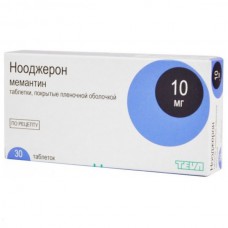Expiration date: 10/2026
The composition and form of issue:
Tablets, film-coated. 1 tablet contains active substance:
memantine 8,31 mg
(in the form of memantine hydrochloride 10 mg)
excipients: MKC — 136,8 mg calcium hydrogen phosphate — 84.5 mg croscarmellose sodium and 4.8 mg of colloidal silicon dioxide and 1.5 mg of magnesium stearate and 2.4 mg
shell film: Opadry II grey 45F27505 8 mg (polymer-2919, 15 SP 2.5 mg, Polydextrose 2.5 mg, titanium dioxide — 2,48 mg, macrogol/macrogol 4000 — 0.5 mg of dye iron oxide black — 0.02 mg)
in blisters of PVC/UN/aluminum foil 10 PCs. in cardboard pack of 3, 6 or 9 blisters.
Description pharmaceutical form:
Oval biconvex tablets are gray, film-coated, engraved with "10" and mark between the numbers on one side and engraved "MM" and mark between the letters on the other side.
In cross section shows a core of white, or almost white.
Pharmacokinetics:
Rapidly and completely absorbed after ingestion. Cmax is reached after 3-8 h after administration. Food does not affect absorption. A daily dose of 20 mg leads to plasma Css from 70 to 150 ng/ml. Vd is 10 l/kg protein Binding is 45%. 80% circulating in the blood of memantine presented by the unmodified substance. Metabolism occurs without the participation of cytochrome P450. The primary metabolites are N-3,5-dimethylhydantoin (2 isomers) and 1-nitroso-3,5-dimethyl-adamantan — have no pharmacological activity.
Excreted by the kidneys. Elimination occurs single-phase, T1/2 is 60-100 h ground clearance — 170 ml/min/1,73m2, the drug is partially secreted in the renal tubules. In alkaline urine excretion of the drug is slowed down.
Description pharmacological action:
Adamantane derivative, the chemical structure and pharmacological properties similar to amantadine. Is a non-competitive antagonist of the glutamate N-methyl-D-aspartate (NMDA) receptors (black substance), thereby reducing the excessive stimulatory effect of cortical glutamate neurons in neostriatum developing on the background of inadequate allocation of dopamine. Reducing the flow of Ca2+ in neurons, reduces the possibility of their destruction. Possesses nootropic, cerebrovasculature, antihypoxic and psychoactive effect. A greater impact on stiffness (rigidity and bradykinesia). Improves weakened memory, concentration, reduces fatigue and symptoms of depression.
Indications:
Dementia moderate and severe degrees of severity in Alzheimer's disease.
Contraindications:
- hypersensitivity to any component of the drug
- severe liver failure
- pregnancy
- breastfeeding
- the age of 18 years (the efficacy and safety of the drug has not been studied).
Caution: epilepsy, renal failure, hyperthyroidism, spasms in anamnesis, arterial hypertension, myocardial infarction history, heart failure.
Application of pregnancy and breast-feeding:
Memantine has the ability to slow the development of the fetus. At the time of treatment with memantine breastfeeding should be interrupted.
Side effects:
From the nervous system: dizziness, headache, drowsiness, gait disorders, confusion, hallucinations, convulsions, psychosis, irritability.
Gastrointestinal: constipation vomiting, pancreatitis, nausea.
Infections and infestations: fungal infection.
From the CCC: increased blood pressure, venous thrombosis, thromboembolism.
From the body as a whole: weakness, fatigue, allergic reactions.
Drug interactions:
While the appointment may weaken the effect of barbiturates and neuroleptics.
The effect of baclofen and dantrolene can change under the influence of memantine, and therefore may require adjustment of their doses.
The effects of levodopa, dopamine receptor agonists and anticholinergics are aggravated by concomitant use of NMDA antagonists. Due to the fact that memantine and amantadine are the antagonists of NMDA receptors, should avoid simultaneous use in connection with risk of development of toxic effect. Are also potentially toxic combination of memantine with ketamine, dextromethorphan, and phenytoin.
For transport of amantadine, cimetidine, ranitidine, quinidine, quinine and nicotine in the body use the same renal cationic system, which may determine the interaction of these drugs with memantine, resulting in an increase in its concentration in blood plasma.
While the use of memantine may decrease the concentration of metoprolol in blood serum.
While the use of warfarin and other indirect anticoagulants requires careful monitoring of PV and INR.
Method of application and dose:
Inside, regardless of meals.
During the first week the daily dose is 5 mg (in the morning). In the second week the daily dose is 10 mg (5 mg 2 times a day). During the third week of a daily dose — 15 mg daily (10 mg morning and 5 mg in the evening). From the fourth week the daily dose is 20 mg per day. The maximum daily dose of 20 mg per day. Dose adjustment in elderly patients (older 65 years) not required.
When moderate renal insufficiency (Cl creatinine 50-80 ml/min) dose adjustment is not usually required when Cl creatinine 30-49 ml/min the daily dose initially 10mg, then after 7 days under the condition of good endurance dose can be increased up to 20 mg. In severe renal failure (Cl creatinine 5-29 ml/min) daily dose should not exceed 10 mg.
At easy and moderate hepatic insufficiency (class and on the classification of child-Pugh) dose adjustment is not required.
Overdose:
Symptoms: dizziness, tremor, agitation, drowsiness, dizziness, agitation, stupor, seizures, aggressiveness, hallucinations, unsteady gait, vomiting, diarrhea.
Treatment: gastric lavage, the appointment of activated carbon symptomatic therapy. There is no specific antidote.
Special instructions:
In alkaline urine requires more careful monitoring of such patients because of slowing of excretion of memantine.
It is known that Alzheimer's disease affects the ability to drive a car in addition, treatment with memantine can also change the speed of reaction that should be considered when driving and mechanisms.




